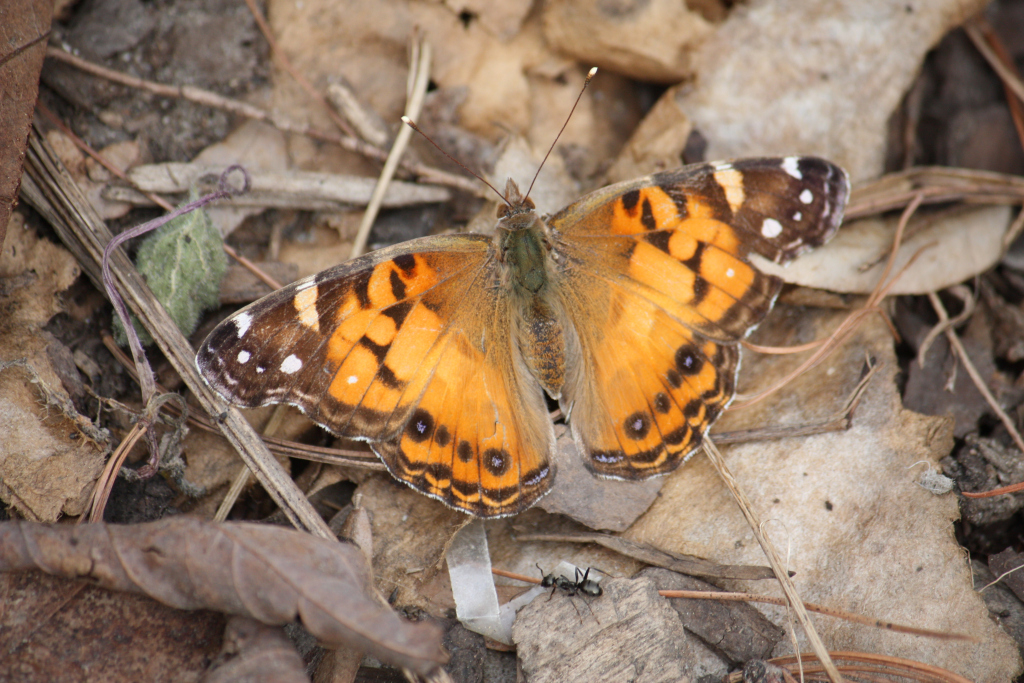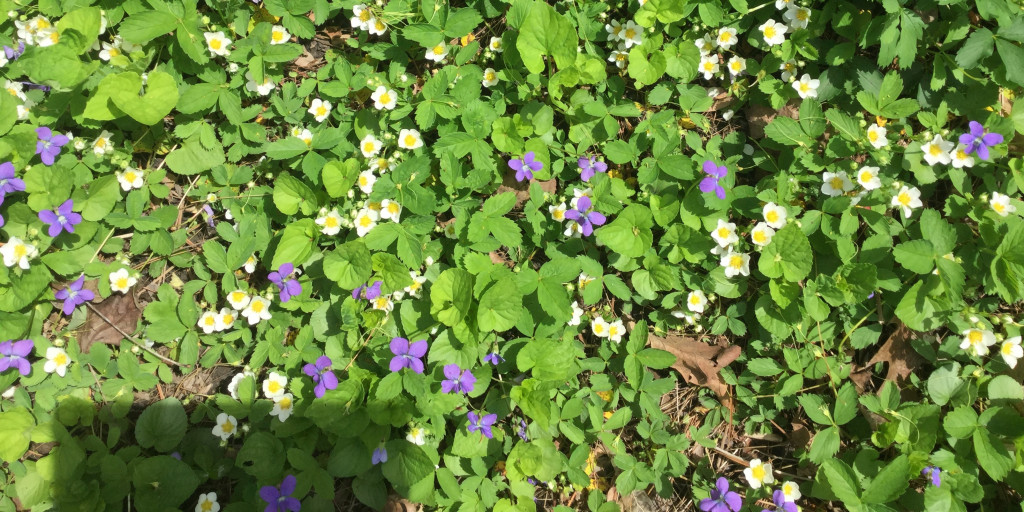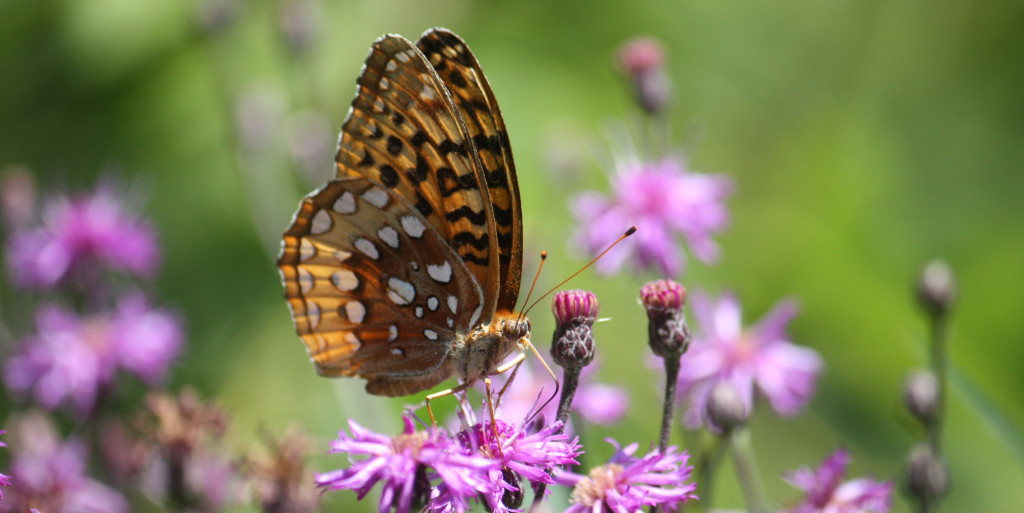by Sandy Garland
Butterflies are not the best pollinators. As they perch on flowers with their long slender legs, they generally avoid the flower parts offering pollen. However, because they are so active, visiting many flowers for nectar, and can cover large areas, they can accidentally move pollen from one bloom to the next. According to the United State Forestry Service, butterflies typically visit flowers that are
- In clusters and provide landing platforms (e.g., Flat-topped Aster)
- Brightly coloured (red, yellow, orange)
- Open during the day
- Ample nectar producers, with nectar deeply hidden (as they have long straw-like tongues)
- Nectar guides present
- May be clusters of small flowers (e.g., goldenrods, spirea)

Close-up of a Common Milkweed floret shows the five “pits” containing pollinia. Nectar is produced in the centre of the flower (photo by Christine Hanrahan)
Milkweeds, the host plant for Monarch caterpillars, also has a pollination mechanism that suits butterflies and moths. Milkweed pollen is packed into sacs called pollinia. The long legs of butterflies are particularly likely to slip into one of the cavities holding a pollinia and become stuck to the pollen. As the butterfly flies off to another flower, it carries this pollen sac attached to its leg and can reverse the process, depositing pollen on the second flower. For a detailed description, see Snared by a milkweed.
In Pollinators of Native Plants (page 25), Heather Holm says that some plants, such as Prairie Phlox, are pollinated primarily by butterflies and moths. Swallowtails transfer pollen grains on their broad wings, which brush against anthers as they sip nectar.
From the Corner Pollinator Garden
WPP partner, Berit Erickson, recently wrote three blog posts on butterfly visitors to her garden. Please click on the links to see these postings, which are full of garden ideas and observations, but here is a brief summary.
Tips for butterfly watching (click to see full blog post)
- Keep an eye on their favourite places – And make some of those favourite places by planting at least three plants of the same species together to increase the chance they’ll be spotted by a passing butterfly.
- Choose a sunny, calm afternoon – Don’t even bother looking for butterflies early in the morning because they aren’t active in cooler temperatures.
- Be still and give them some space – If you’re moving around, get too close, or cast a shadow on or near a butterfly, it might mistake you for a predator and fly away. Use binoculars or camera for a better view.
- Be patient and watch for movement – Once you stay put and observe, you’ll be surprised how much insect activity you’ll see. The same trick works for spotting birds.
Berit also includes some resources for identifying butterflies, both field guides and online sites.
Butterfly spotting, part 1: common butterflies in the garden (click to see full blog post)
- American Lady butterflies (see photo below and more on the Corner Pollinator Garden web site) like open spaces with low vegetation, like our mini-meadow and hedgerow. The first generation lays eggs in spring on Pussytoes varieties and Pearly Everlasting.
- Eastern Black Swallowtail butterflies use some common non-native herbs as host plants, such as Dill, Fennel, Rue, and Parsley. They also use some invasive weeds, namely Queen Anne’s Lace and Wild Parsnip, as host plants.
- Giant Swallowtail butterflies are a spectacular sight, with a wingspan of up to 6.5 inches and a very graceful flight. While they drink nectar from flowers, however, they are ridiculously frantic; perhaps they are so big that they have to hover while they drink.
- Monarch butterflies – I have never seen so many Monarchs in the garden before; they were drinking nectar, basking, roosting, mating, and laying eggs. You can find more about “our” Monarchs in my past blog post A great summer for Monarchs.

An American Lady butterfly resting on leaf litter, and being photo-bombed by an ant (photo by Berit Erickson, 22 May 2019)
Butterfly spotting, part 2: new butterfly visitors (click to see full blog post)
- Great Spangled Fritillary – I read that fritillaries use native violets as host plants, and I am letting them spread, along with Wild Strawberries, to form a natural, living mulch beneath my hedgerow shrubs (see photo below).
- Red Admiral – Against my better judgement, I moved a Stinging Nettle seedlings to my pollinator garden for Red Admirals. I now know that Stinging Nettle spreads vigorously through its root system and seeds.
- White Admirals lay eggs on a variety of shrubs and trees, such as the willow, birch, native cherries, and oak that are in our yard. The adult butterflies are also fans of sap, rotting fruit and animal droppings.
- Mourning Cloak – Like the admirals, Mourning Cloaks also feed on sap and dung. They overwinter as adult butterflies, hiding under bark or leaves.

This thriving patch of Wild Strawberries and Common Blue Violets was alive with pollinators in the spring. I watched ground-nesting bees gathering pollen, and returning to their nests beneath the leaves (photo by Berit Erickson, 26 May 2019)
As pollinators, butterflies may not be as efficient as bees, but they certainly play an important role in our enjoyment of nature. Attracting them to your garden means planting a variety of mostly native plants to provide nectar all season long. If you really want butterflies to stay in your garden for a while, make sure to include the host species their caterpillars need. You can find a list on the Fletcher Wildlife Garden web site (Gardening for Butterflies).
